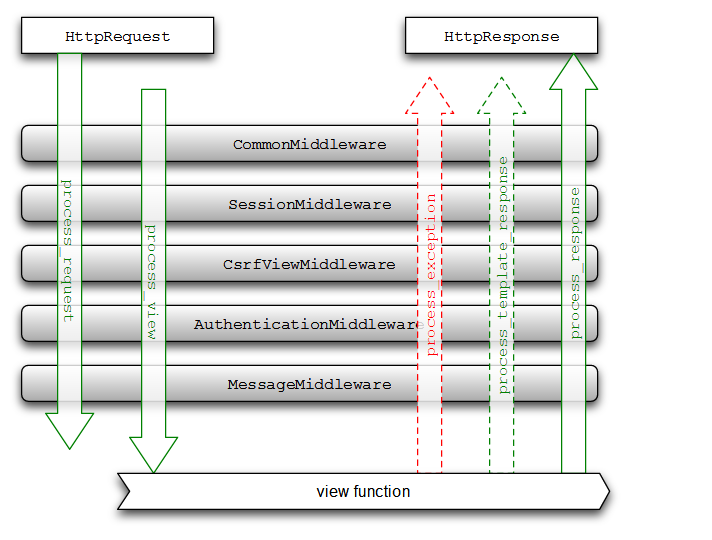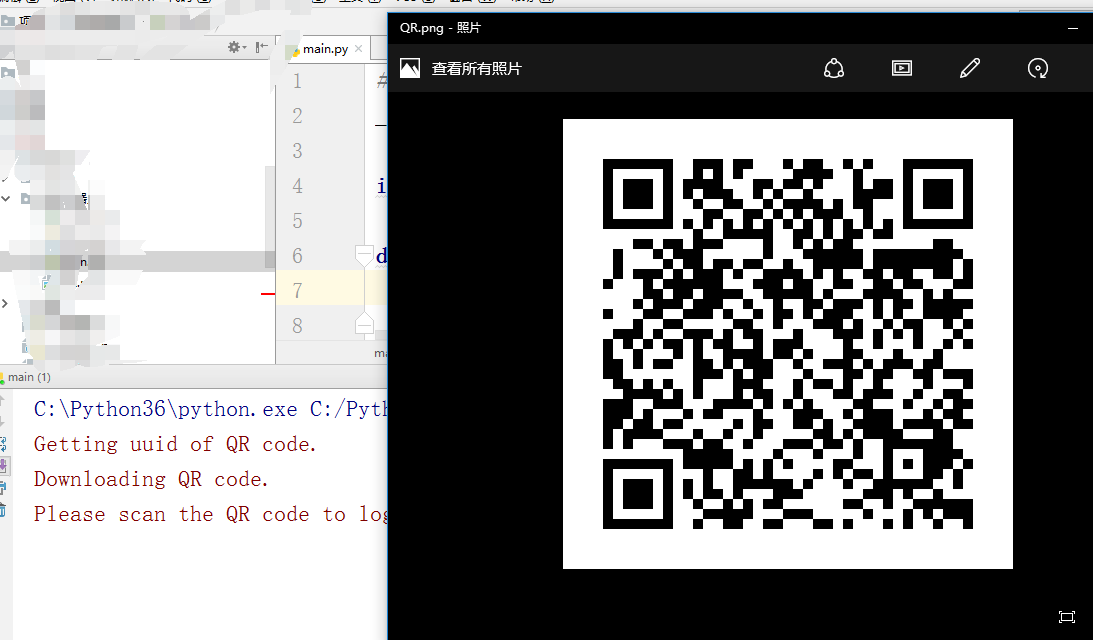Django教程笔记之中间件middleware详解
中间件介绍
中间件顾名思义,是介于request与response处理之间的一道处理过程,相对比较轻量级,并且在全局上改变django的输入与输出。因为改变的是全局,所以需要谨慎实用,用不好会影响到性能。
每个中间件都会负责一个功能,例如,AuthenticationMiddleware,与sessions处理相关。
激活中间件
需要在settings.py配置文件中,配置MIDDLEWARE_CLASSES:
MIDDLEWARE_CLASSES = [ 'django.middleware.security.SecurityMiddleware', 'django.contrib.sessions.middleware.SessionMiddleware', 'django.middleware.common.CommonMiddleware', 'django.middleware.csrf.CsrfViewMiddleware', 'django.contrib.auth.middleware.AuthenticationMiddleware', 'django.contrib.auth.middleware.SessionAuthenticationMiddleware', 'django.contrib.messages.middleware.MessageMiddleware', 'django.middleware.clickjacking.XFrameOptionsMiddleware', ]
当然你也可以不试用任何的中间件,这个可以设置为空。
中间件顺序
一般我们我们从浏览器发出一个请求 Request,得到一个响应后的内容 HttpResponse ,这个请求传递到 Django的过程如下,process request 和 process response的执行顺序正好相反,如下图所示:

也就是说,每一个请求都是先通过中间件中的 process_request 函数,这个函数返回 None 或者 HttpResponse 对象,如果返回前者,继续处理其它中间件,如果返回一个 HttpResponse,就处理中止,返回到网页上。
中间件不用继承自任何类(可以继承 object ),下面一个中间件大概的样子:
class CommonMiddleware(object): def process_request(self, request): return None def process_response(self, request, response): return response
需要用到的几个hook:
- process_request()
- process_exception() (only if the view raised an exception)
- process_template_response()
- process_response()
常用的中间件组件:
1. Sessions
2. Authentication
3. CSRF Protection
4. GZipping Content
例如,比如我们要做一个 流量统计
class BlockedIpMiddleware(object): def process_request(self, request): ...数据库拿access值 access = access+1 ...存起来,类似这个原理
这里的代码的功能就是 简单的访问一次加一次,把这个中间件的 Python 路径写到settings.py中
MIDDLEWARE_CLASSES = ( 'zjj.middleware.BlockedIpMiddleware', ...其它的中间件 )
Django 会从 MIDDLEWARE_CLASSES 中按照从上到下的顺序一个个执行中间件中的 process_request 函数,而其中 process_response 函数则是最前面的最后执行。
二,再比如,我们在网站放到服务器上正式运行后,DEBUG改为了 False,这样更安全,但是有时候发生错误不能显示错误详情页面,有没有办法处理好这两个事情呢?
普通访问者看到的是友好的报错信息
管理员看到的是错误详情,以便于修复 BUG
当然可以有,利用中间件就可以做到!代码如下:
import sys
from django.views.debug import technical_500_response
from django.conf import settings
class UserBasedExceptionMiddleware(object):
def process_exception(self, request, exception):
if request.user.is_superuser or request.META.get('REMOTE_ADDR') in settings.INTERNAL_IPS:
return technical_500_response(request, *sys.exc_info())
把这个中间件像上面一样,加到你的 settings.py 中的 MIDDLEWARE_CLASSES 中,可以放到最后,这样可以看到其它中间件的 process_request的错误。
当访问者为管理员时,就给出错误详情,比如访问本站的不存在的页面。
普通人看到的是普通的 404(自己点开看看),而我们却可以看到。
三,分享一个简单的识别手机的中间件,更详细的可以参考这个:django-mobi
MOBILE_USERAGENTS = ("2.0 MMP","240x320","400X240","AvantGo","BlackBerry",
"Blazer","Cellphone","Danger","DoCoMo","Elaine/3.0","EudoraWeb",
"Googlebot-Mobile","hiptop","IEMobile","KYOCERA/WX310K","LG/U990",
"MIDP-2.","MMEF20","MOT-V","NetFront","Newt","Nintendo Wii","Nitro",
"Nokia","Opera Mini","Palm","PlayStation Portable","portalmmm","Proxinet",
"ProxiNet","SHARP-TQ-GX10","SHG-i900","Small","SonyEricsson","Symbian OS",
"SymbianOS","TS21i-10","UP.Browser","UP.Link","webOS","Windows CE",
"WinWAP","YahooSeeker/M1A1-R2D2","iPhone","iPod","Android",
"BlackBerry9530","LG-TU915 Obigo","LGE VX","webOS","Nokia5800")
class MobileTemplate(object):
"""
If a mobile user agent is detected, inspect the default args for the view
func, and if a template name is found assume it is the template arg and
attempt to load a mobile template based on the original template name.
"""
def process_view(self, request, view_func, view_args, view_kwargs):
if any(ua for ua in MOBILE_USERAGENTS if ua in
request.META["HTTP_USER_AGENT"]):
template = view_kwargs.get("template")
if template is None:
for default in view_func.func_defaults:
if str(default).endswith(".html"):
template = default
if template is not None:
template = template.rsplit(".html", 1)[0] + ".mobile.html"
try:
get_template(template)
except TemplateDoesNotExist:
pass
else:
view_kwargs["template"] = template
return view_func(request, *view_args, **view_kwargs)
return None
再举一个本地化的中间件的例子:
class LocaleMiddleware(object): def process_request(self, request): if 'locale' in request.cookies: request.locale = request.cookies.locale else: request.locale = None def process_response(self, request, response): if getattr(request, 'locale', False): response.cookies['locale'] = request.locale
就是将cookies中的locale设置给request中的locale,供给后面使用。
这部分参考了django官方文档以及网络上的一些教程,这里也非常感谢这些前辈的分享。
总结
以上就是这篇文章的全部内容了,希望本文的内容对大家的学习或者工作具有一定的参考学习价值,如果有疑问大家可以留言交流,谢谢大家对【听图阁-专注于Python设计】的支持。
